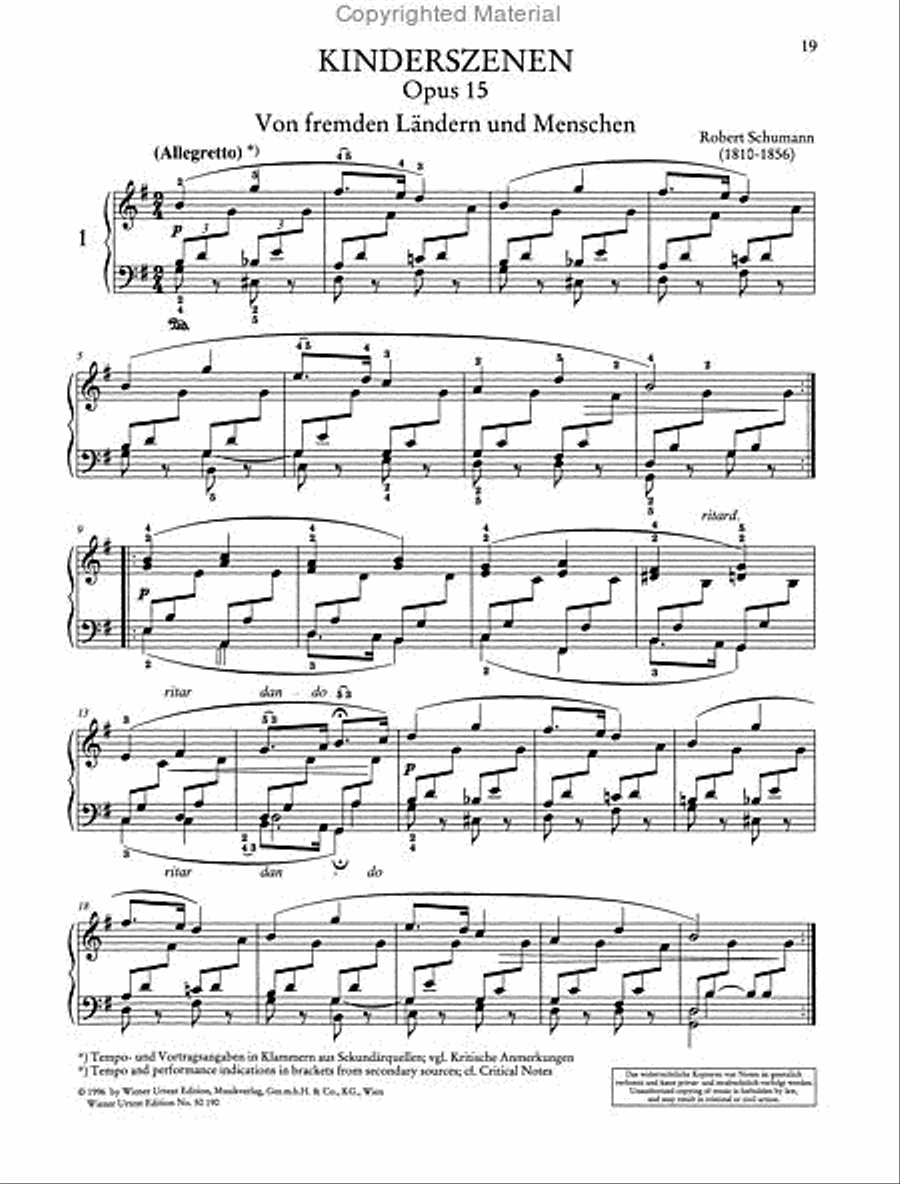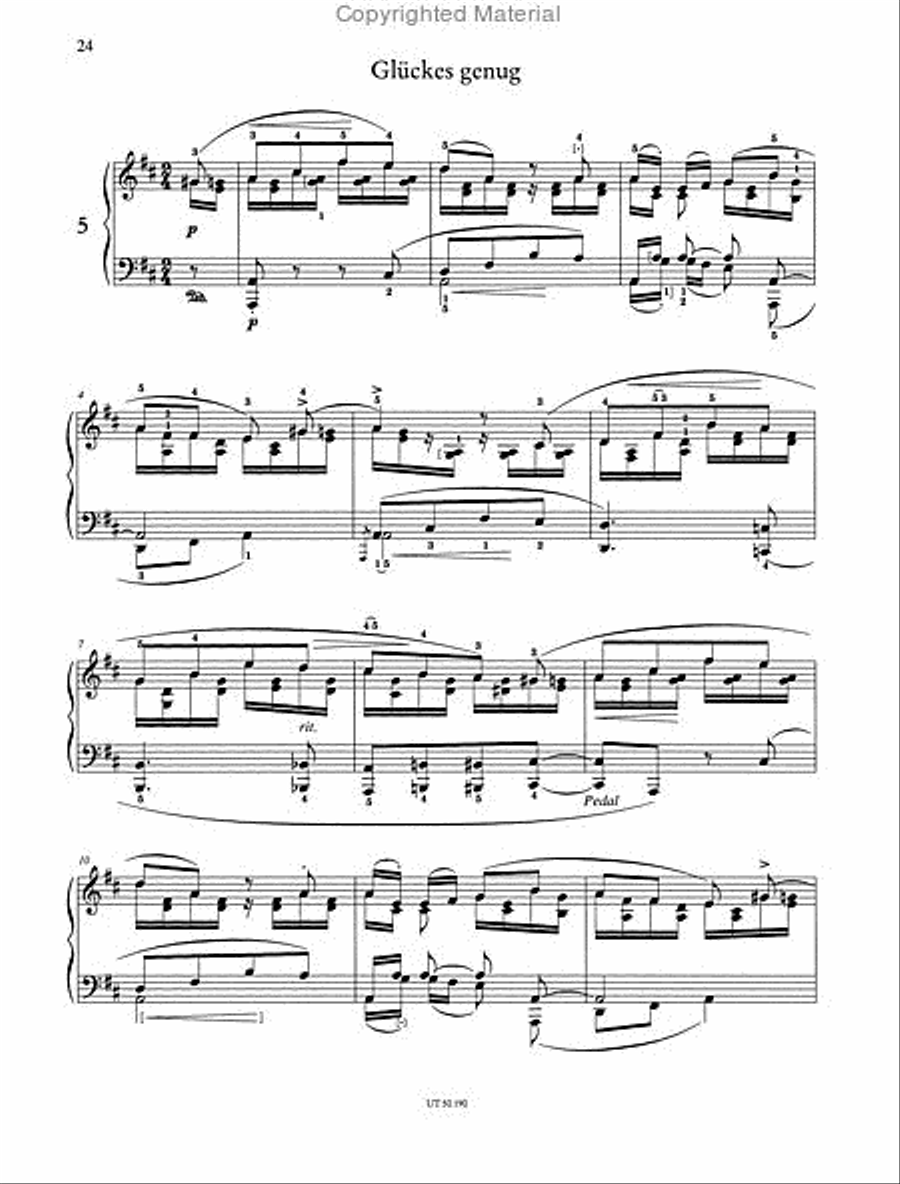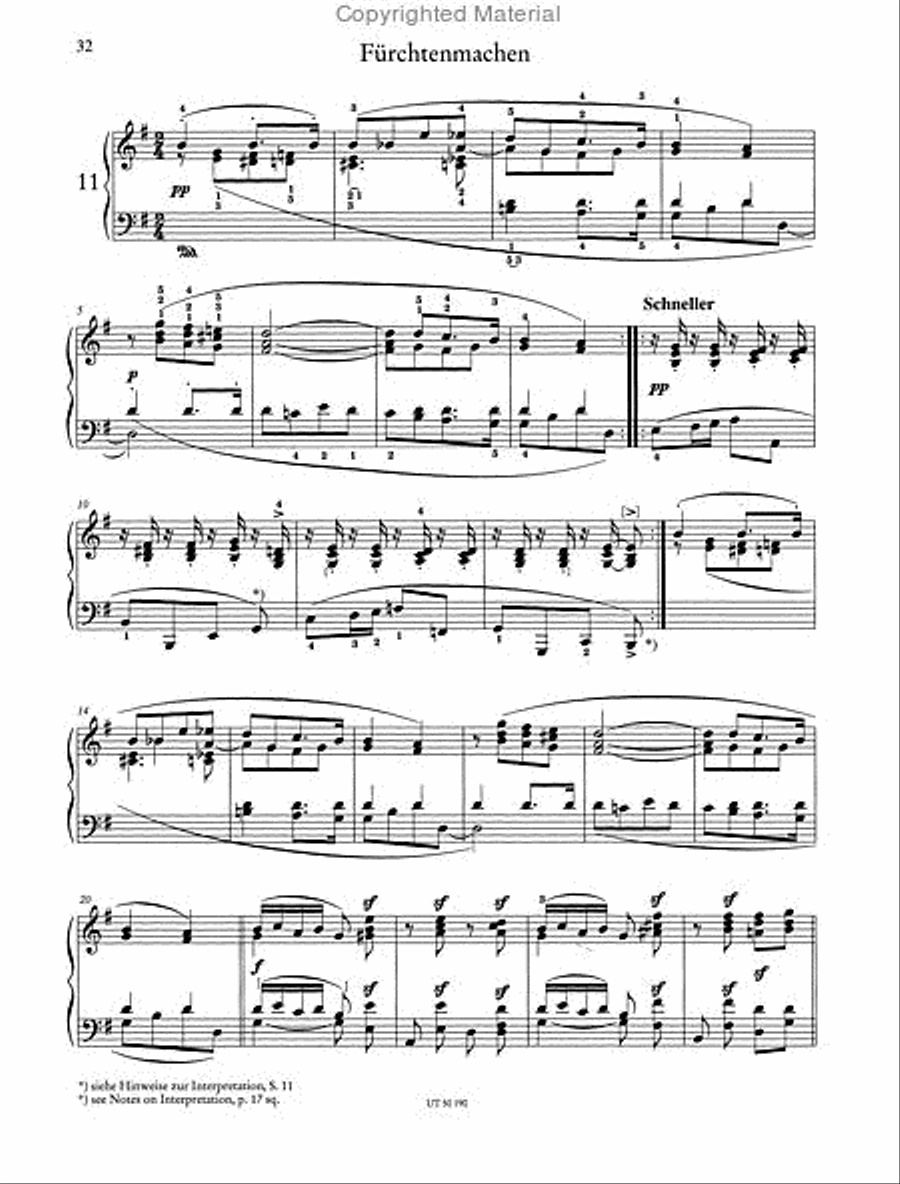
Happy Present Meet
Schumann Scenes from Childhood Op.15 for Piano Solo
Kinderszenen Op.15 (with critical notes)
fingering: Beenhouwer, Jozef de
editor: Draheim, Joachim
notes on interpretation: Beenhouwer, Jozef de
composer: Schumann, Robert
preface: Draheim, Joachim
Easy pieces for the Pianoforte. Edited from the sources
Urtext
Difficulty: intermediate - advanced
Level: SMP Level 8 (Early Advanced) / Advanced
Publication year: 1996
Year of composition: 1838
Content
Von fremden Landern und Menschen (Of Foreign Lands And Peoples), G major
Kuriose Geschichte (A Curious Story), D major
Hasche-Mann (Blind Man`s Buff), B minor
Bittendes Kind (Pleading Child), D major
Gluckes genugH (Happiness), D major
Wichtige Begebenheit (An Important Event), A major
Traumerei (Dreaming), F major
Am Kamin (At The Fireside), F major
Ritter vom Steckenpferd (Knight Of The Hobbyhorse), C major
Fast zu ernst (Almost Too Serious), G-sharp minor
Furchtenmachen (Frightening), E minor
Kind im Einschlummern (Child Falling Asleep), E minor
Der Dichter spricht (The Poet Speaks), G major
The Kinderszenen, composed in the spring of 1838, are among the most well-known and popular works of piano literature. Above all, No. 7, the Reverie, began an unprecedented triumphal march through the music world from the second half of the 19th century. The present, carefully revised edition takes into account for the first time manuscript improvements and changed tempo indications of Schumann's hand in one of the two surviving copies of the first edition of 1839, which came into the possession of the Robert Schumann House in Zwickau in 1994.
This edition differs from the "instructive edition" by Clara Schumann, among others, by the metronome information, why the pieces in terms of their tempo and their phrasing of the previously familiar sound differ significantly.
1838년 봄에 작곡된 킨더슈만 정경(Kinderszenen)은 피아노 문학에서 가장 유명하고 인기 있는 작품 중 하나입니다. 특히 7번 '몽상(Reverie)'은 19세기 후반부터 음악계에 전례 없는 승리의 행진을 시작했습니다. 신중하게 개정된 이번 개정판은 1839년 초판본의 현존하는 두 권 중 한 권에서 슈만의 악보 수정 및 템포 표시 변경을 처음으로 반영했습니다. 이 초판은 1994년 츠비카우의 로베르트 슈만 하우스에 소장되었습니다.
이번 개정판은 클라라 슈만을 비롯한 다른 작곡가들의 "교훈적인 개정판"과는 메트로놈 정보에서 차이를 보이는데, 이 때문에 각 곡의 템포와 이전에 익숙했던 음색의 프레이징이 상당히 다릅니다.
Scenes of Childhood
In every child there lie wonderful depths. Robert SchumannThis Wiener Urtext Edition of Scenes of Childhood has several extensive commentaries in German and English. There is a wealth of information to guide us. In learning these pieces we may bring three of Clara Schumanns most important artistic principles: the most punctilious conscientiousness, exhaustive elucidation of the musical content and the avoidance of all exaggeration. These pieces vary, but not too much, in difficulty. Having said that I should qualify it by saying that numbers 3 and 9 require to be played rather fast. The first simple though it may appear presents a difficulty as we have two hands playing different rhythms. Many of us have played it wrongly. The last bar in each line is numbered and this is a help for both student and teacher. Pablo Casals said these pieces are so delicate and expressive.
어린 시절의 풍경
모든 아이에게는 놀라운 깊이가 있습니다. 로베르트 슈만, 이 빈 원문판 어린 시절의 풍경에는 독일어와 영어로 된 풍부한 해설이 수록되어 있습니다. 우리를 이끌어 줄 풍부한 정보가 담겨 있습니다. 이 곡들을 배우면서 우리는 클라라 슈만의 가장 중요한 예술 원칙 세 가지, 즉 가장 꼼꼼한 성실함, 음악적 내용에 대한 철저한 설명, 그리고 모든 과장의 회피를 체득하게 될 것입니다. 이 곡들은 난이도가 다양하지만, 그다지 높지는 않습니다. 하지만 3번과 9번은 상당히 빠르게 연주해야 한다는 점을 덧붙이고 싶습니다. 첫 번째 곡은 간단해 보일지 모르지만, 두 손으로 다른 리듬을 연주해야 하기 때문에 어려움을 겪습니다. 많은 사람들이 이 곡을 잘못 연주해 본 적이 있을 것입니다. 각 줄의 마지막 마디에는 번호가 매겨져 있어 학생과 교사 모두에게 도움이 됩니다. 파블로 카잘스는 이 곡들이 매우 섬세하고 표현력이 풍부하다고 말했습니다.
Highly recommended edition of this work
At first glance one may ask: Where are Schumann's metronome markings, printed in other urtext editions and even promoted online by Henle? But a seven-page preface, after tracing Kinderszenen's genesis and reception and publication and history, thoroughly addresses this question. The metronome markings from the corrected first edition (1839) are listed together with counter-suggestions by Otto Bhme (a friend of Schumann's) and Clara Schumann. Their exclusion from the main text is justified by evidence (downplayed by Henle) that they were added without Schumann's knowledge. These markings will not absolve today's performers from finding their own appropriate tempi...although all three...will generally serve to counteract the current widespread tendency to sentimentalise these works by dragging the tempi. The notes on interpretation (which extensively quote Robert, Clara, and Clara's students) are also illuminating. Plus, I find the fingering suggestions readable and effective. Bravo!
이 작품의 강력 추천판
처음에는 이렇게 질문할 수 있습니다. 다른 원전(urtext)에 인쇄되어 있고 심지어 헨레가 온라인으로 홍보하기까지 한 슈만의 메트로놈 표시는 어디에 있습니까? 하지만 7페이지 분량의 서문은 <킨더젠넨>의 기원, 수용, 출판, 그리고 역사를 추적하며 이 질문을 철저히 다룹니다. 1839년 수정된 초판의 메트로놈 표시는 슈만의 친구였던 오토 브메와 클라라 슈만의 반론과 함께 나열되어 있습니다. 본문에서 메트로놈 표시가 제외된 것은 (헨레가 간과한) 슈만이 모르게 추가되었다는 증거에 의해 정당화됩니다. 이러한 표시가 오늘날의 연주자들이 자신에게 맞는 템포를 찾는 데서 자유로울 수는 없지만, 세 가지 표시 모두 템포를 끌어서 감상적으로 만드는 오늘날의 광범위한 경향을 상쇄하는 데 도움이 될 것입니다. 해석에 대한 노트(로버트, 클라라, 그리고 클라라의 제자들의 글을 광범위하게 인용함)도 매우 유익합니다. 게다가 운지법 관련 조언도 읽기 쉽고 효과적이라고 생각합니다. 훌륭합니다!
편곡자 Draheim
작곡가 Schumann,Robert(1810-1856)
에디터 Draheim, Joachim



Rachmaninoff Etudes Tableaux Op.33 & 39 for Piano Solo
[Franz] 마스킹 테이프 - De Largo a Vivace (검정, 흰색)
Schumann Forest Scenes Op.82 for Piano Solo
Music Post-it Op.6-2 (포켓) 포스트잇 오선메모지 - 화이트 -
Schubert Impromptus and Moments Musicaux for Piano Solo
Bach Collected Transcriptions for Piano Solo
Schumann Scenes from Childhood Op.15 for Piano Solo
Schumann-Liszt Liebeslied (Widmung) aus "Myrthen" Op.25 for Piano Solo